
Reconstructing algal ecology with novel genetic biomarkers
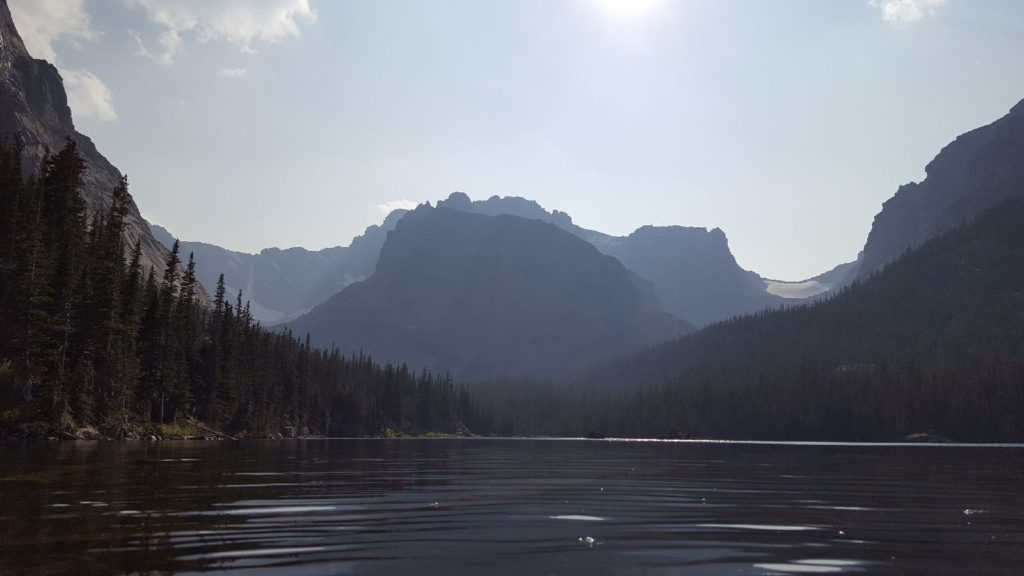
Written by Mitch Ralson
There we are hunkered down in our inflatable raft piled with gear and suspended in the sky as another day of fieldwork is underway within the encompassing columbine meadows of the Rocky Mountain alpine. As we slowly glide our way across the calm water made of glass, quiet ripples drift away gently morphing the lake’s perfect reflection of the blue sky. The early morning sun summits a distant peak, warming the crisp mountain air around us and softly illuminating the clear water. But as we continue to paddle across the lake, the crystal water turns oddly green from stringy filaments swaying softly beneath the world above.
These slimy, green filaments, called algae, are a diverse group of photosynthetic organisms that are found nearly everywhere on earth. Despite their ubiquity, it is unusual to observe large swaths covering high elevation lakes. Thus, pristine mountainous lakes or alpine lakes have recently received greater attention from more than just outdoor enthusiasts.
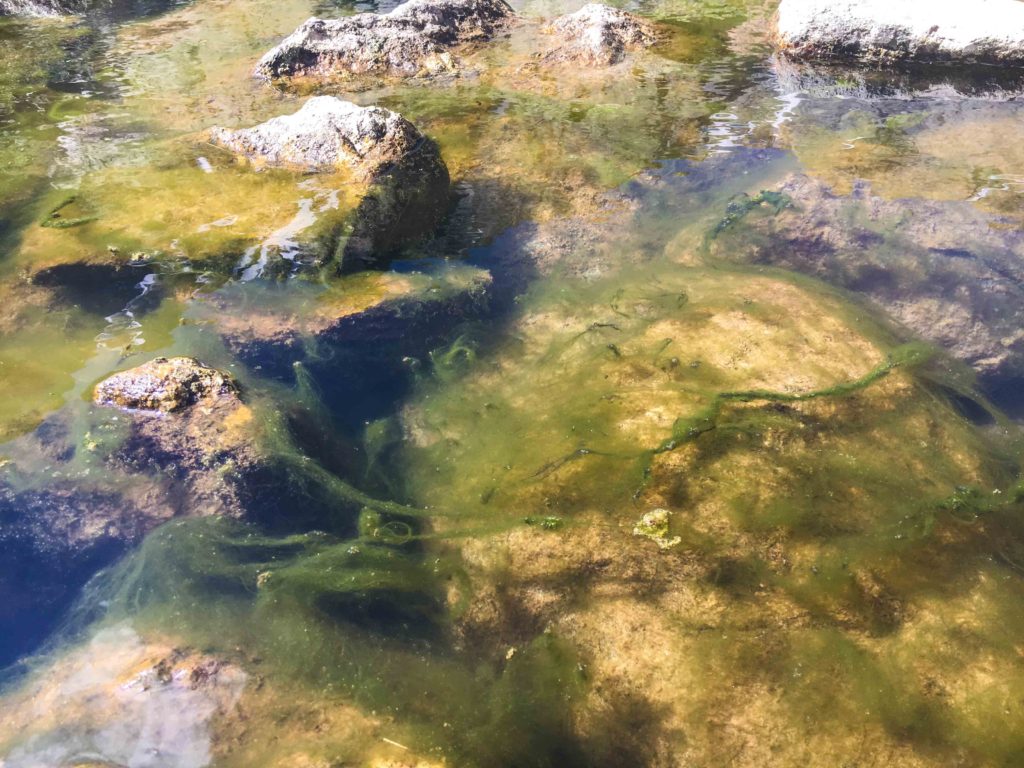
In the Rocky Mountains of Colorado, mats of algae, called algal blooms, are becoming a familiar view at our research site at Sky Pond, an alpine lake located at 11,000 feet within Rocky Mountain National Park. Even though Sky Pond has its own quiet-living algal communities, the presence of bloom-forming algae is a strange new occurrence.
Since the early 1980’s, Jill Baron, a senior researcher at the United States Geologic Survey (USGS) and the Natural Resource Ecology Laboratory (NREL) at Colorado State University, has been observing a variety environmental changes affecting Sky Pond. The algal blooms have only been observed since 2011, and only if you are looking — a rather subtle change to even the most perceptive adventurers.
When most hikers bask in their accomplishments after a strenuous journey to the shores of Sky Pond, they see a beautiful, untouched lake surrounded by towering cliffs. When our research team paddles out onto the lake, however, we notice the sea of green that forms patches along the lake’s floor. Curious about these recent changes, our research team sought to understand how the overall algal community has changed over several hundred years of Sky Pond’s history. What could be causing algal blooms in a seemingly pristine alpine lake?
A Surplus of Food
Nitrogen is an essential nutrient for life. It is a crucial component of DNA and it fuels internal bodily functions that make daily life possible for all living beings. Despite nitrogen’s abundance in the atmosphere, it is typically limited within terrestrial and aquatic environments, where only 0.01% of all species on the planet can tap into the atmospheric reservoir.
Since the early 20th century, humans have been able to grab unusable N2 from the atmosphere. Through the Haber Bosch process, N2 gas can be sucked out and reconstructed into a usable form, like ammonia (NH3), which is commonly used in crop fertilizers. Consequently, the steep rise of industrially-created nitrogen has dramatically increased the amount of nitrogen within the environment.
As more fertilizers are dumped atop plowed fields to feed hungry crops, nitrogen doesn’t stay where it’s put in the soil; it travels throughout the landscape. Therefore, soils and water sources in agricultural regions have higher nitrogen concentrations due to leaky nitrogen compounds. Within the frigid waters of Sky Pond, the abundance of nitrogen is abnormally high, especially for a historically nutrient-limited lake. Clearly, there are no cattle grazing the alpine nor are there fertilized crop fields snuggled between glacial moraines. Where is all this nitrogen coming from?
Along Colorado’s Front Range, a mosaic of urban cities, industrial agriculture, and rangelands flood the prairies in the shadow of snow-capped mountains to the west. As wind flows across cities and the feedlots of confined animal feeding operations and dairies, nitrogen from fossil fuel combustion, animal waste, and fertilizers can jump into the air eager for a journey west. When wind-carried nitrogen arrives above the Rockies, it can hitch a ride with water droplets as they pelt the landscape during frequent spring snows and summer rainstorms; a process called atmospheric nitrogen deposition. Sky Pond’s high nitrogen concentrations can be predominately pinned to urban and agricultural emissions from tens of miles away.
Algae need nutrients like nitrogen to survive. For Sky Pond, excess nitrogen means more food and therefore a larger group of algae; like when there are more crops, there can be more humans. With excess nutrients, however, some algae can form thick green blooms that are often considered indicators of an ecosystem’s health. When algal blooms form on the surface of the water, it is like a solar eclipse; they can block out sunlight to other photosynthetic organisms beneath them.
When those algae decompose, oxygen within the water is rapidly consumed, leaving fish and other organisms to suffocate. These severe symptoms of algal blooms occur annually in the Gulf of Mexico, the Chesapeake Bay, and some of the Great Lakes. Such severe symptoms have not yet been observed in Sky Pond. Nonetheless, the small, novel blooms could develop into a major long-term concern, particularly for a sensitive alpine lake.
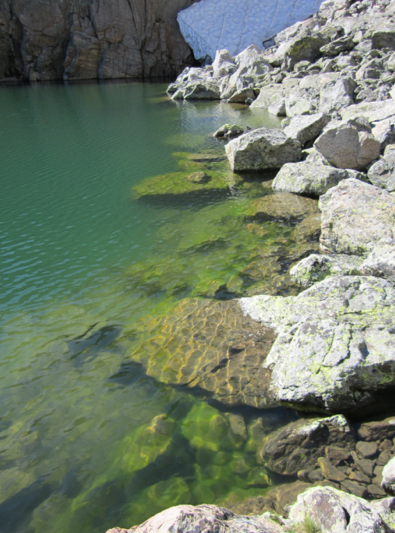
Digging Up Hidden DNA
To further understand how atmospheric nitrogen deposition effects Sky Pond and its algal community over hundreds of years, our research team turned to the lake’s sediment. The bottom of Sky Pond can be considered a historical timeline, where information about water chemistry and the presence of organisms is written. When organisms like algae die, they decompose and disintegrate within the water. As they are broken down by other organisms, their DNA can radiate out into the surrounding environment free from their former cells. This extra-cellular environmental DNA (eDNA) is eventually deposited on the lake’s floor. Slowly over time, eDNA and nutrients become buried and preserved within sediment as more material piles on top. Different sediment layers represent a specific time period of Sky Pond’s history. By probing these layers, not only can we understand the previous nutrient concentrations, like nitrogen, within the lake, but changes in algal abundance and community structure can be determined as well. Thus, it is possible to know which algal groups were living in Sky Pond at a specific time. By association with nutrients and other proxies of past events, we can even determine why the algae lived when they did.
During a blizzard in May of 2016, Baron and Isabella Oleksy, a graduate student at Colorado State University, walked out onto Sky Pond’s frozen surface accompanied by a group of researchers to obtain a copy of Sky Pond’s history transcribed within its sediment. Equipped with an ice auger, the team went to work as snow swirled around them. “We drilled a hole in the ice […] and drove a sediment coring device into the mud at the deepest point in the lake,” describes Oleksy. “The coring device is essentially a large PVC pipe with a heavy weight on top, and gravity drives the tube into the sediment.” The result? A continuous 27-centimeter sediment core chalk full of algal eDNA awaiting to tell the story of Sky Pond’s past.
There is more than just algal eDNA within the sediment layers, however. In order to exclusively capture algal and cyanobacterial DNA, we employed 23s plastid primers. Using polymerase chain reaction (PCR), a standard method to create millions of copies of the desired gene, the primers selectively cut out and copied the algal 23s gene located within their green chloroplasts. After PCR, only the algal and cyanobacterial 23s gene was suspended within test tubes.
The millions of cut-out genes belong to a plethora of algal groups, like intricate, glass-shelled diatoms. Using sequencing technology, this group of algae and others can be identified based on the order of nucleic bases that make up their respective 23s chloroplast gene.
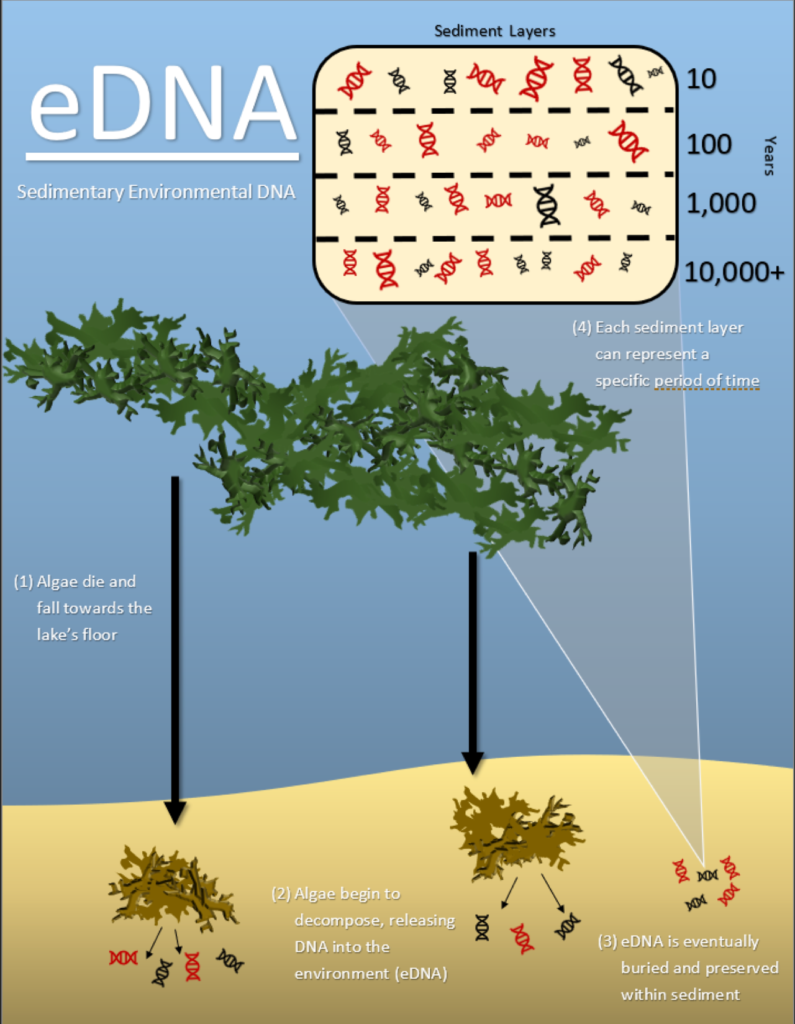
Our algal eDNA research is ongoing and each defined sediment core layer will be isotopically dated to a specific range of years. We anticipate seeing several substantial community shifts. “Prior to major industrial activity and settlement of the Front Range in Colorado,” Oleksy explains, “we expect to see a diverse flora of cyanobacteria and diatoms. By 1950, we expect to see an abrupt change in the flora with one particular diatom, Asterionella formosa, being the dominant species.” By the end of the 20th century, Asterionella is predicted to still be one of the dominant species within Sky Pond. An increased abundance of cyanobacteria and stringy, filamentous green algae are also predicted to dominate the community.
With this extraordinary information, specific algal species, and their respective abundance can be identified and tied to a specific time in which they floated within the waters of Sky Pond. In addition, our team can use previous sediment core nutrient data from Sky Pond to link algal community composition to nitrogen concentrations. This could, therefore, reveal distinct community shifts and connect the relative abundance of algae to increasing nitrogen concentrations from atmospheric deposition and other environmental disturbances within the lake over the time scale of at least several hundred years.
A Revolutionary Tool
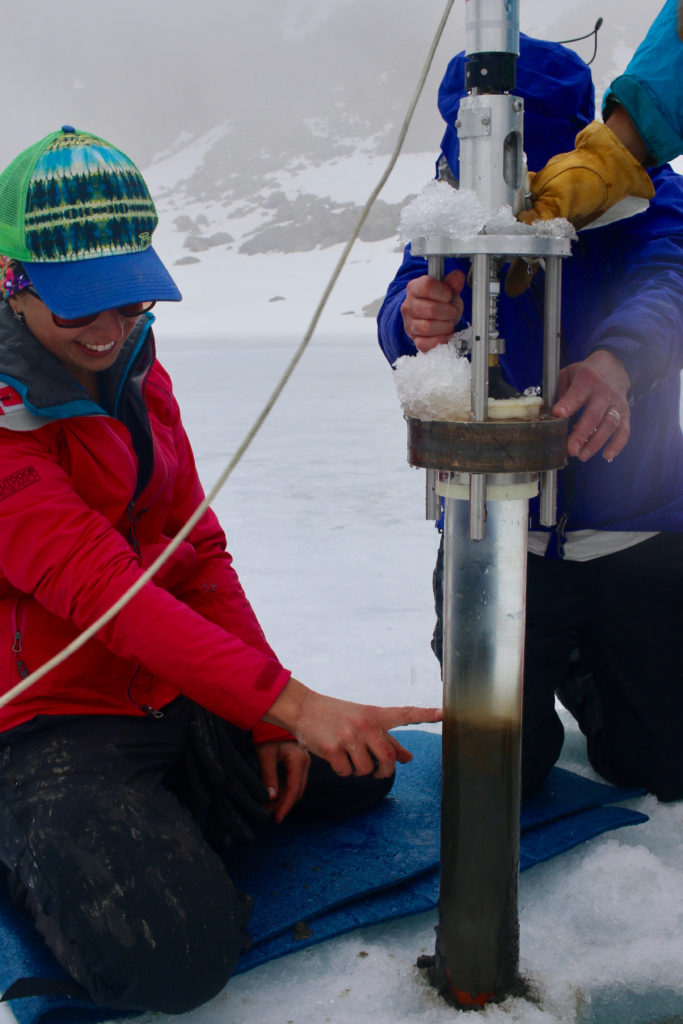
Extracting and identifying environmental DNA from sediments is a cutting-edge approach that can provide incredible insight into the environmental history of an ecosystem. Within the paleo world, researchers traditionally identified algae by analyzing morphological fossils and photosynthetic pigments preserved within sediment layers. In addition to the eDNA analysis, Oleksy extracted pigments from the same Sky Pond sediment core. The abundance of pigments like lutein and zeaxanthin, which are commonly found within the cells of green algae, can indicate when green algae dominated the chilly waters of Sky Pond. Identifying temporal algal community shifts through pigments can be too broad, however. “The pigment method is helpful and scientifically sound, but is a rather coarse analysis,” says Oleksy. “Pigments tell us about broad changes in algal community composition, but do not tell us which species are associated with that shift.”
This is where the novel eDNA approach can step in. We can expect higher resolution identification using preserved eDNA, possibly to the species level instead of general groups from pigment analyses. Not only does this provide greater insight into algal community shifts but could also potentially pinpoint the time period when a parallel increase of the bloom-forming filamentous green algal abundance occurred in relation to elevated nitrogen inputs.
Oleksy also explains that eDNA could follow Sky Pond’s ecological history further back in time. “Another [disadvantage] of the pigment method is that some pigment biomarkers degrade over time, making it difficult to accurately quantify certain algal groups. While eDNA will naturally degrade with time, the rate of degradation is not as rapid.” With less degradation in the deeper, older sediment layers, more eDNA is preserved. This means that a more accurate representation of the algal community can be achieved.
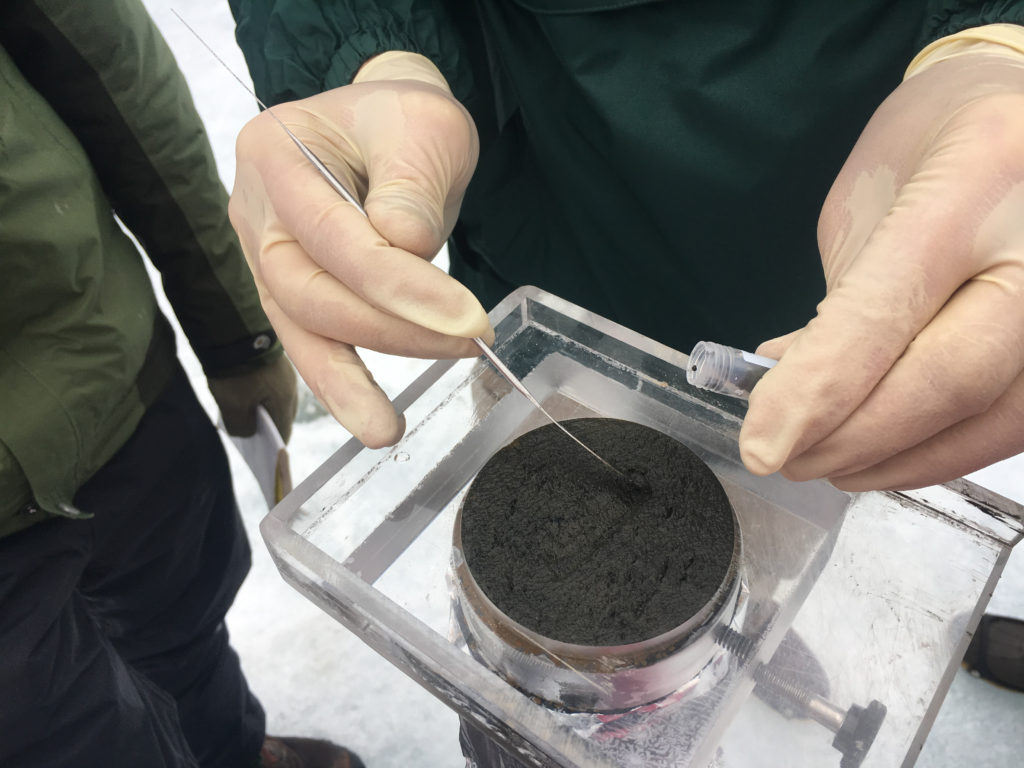
In 2016, one research team led by Gaoyuan Li used the novel eDNA approach in a Chinese alpine lake and achieved astonishing results. Li extracted preserved algal and cyanobacterial eDNA within a sediment core and identified their community shifts for the past 18,500 years. Not only did the team accurately identify the algal and cyanobacterial groups but they also tied their abundance to different environmental variables within the lake and general climatic shifts since the height of the last ice age. Li connected the comparably warmer and nutrient-rich pre-boreal period (10,000 – 8,000 B.C.E.) to a substantial community shift from cold-water algal groups to groups that prefer warmer temperatures, like filamentous green algae.
Although our research is still in progress, we expect to obtain similar results as Li’s research team. With the emergence of sedimentary eDNA analysis, deleterious atmospheric nitrogen deposition into the Rocky Mountains can provide us with substantial evidence of long-term shifts in biological communities and water chemistry within sensitive alpine lakes.
Mitch Ralson is an Ecosystem Science & Sustainability major with minor in botany. This piece is a product of Composition 301B Writing in the Disciplines: Sciences. Mitch graduates in Spring 2018 and is interested in continuing ecological field-based research after graduation.
References:
Li, G., Dong, H., Hou, W., Wang, S., Jiang, H., Yang, J., & Wu, G. (2016). Temporal Succession of Ancient Phytoplankton Community in Qinghai Lake and Implication for Paleo-environmental Change. Scientific Reports, 6(November 2015), 19769.
Unpublished data, 2011. Jill Baron & Isabella Oleksy
Unpublished data, 2017 (research in progress). Mitch Ralson, Isabella Oleksy, and Michael Manzella